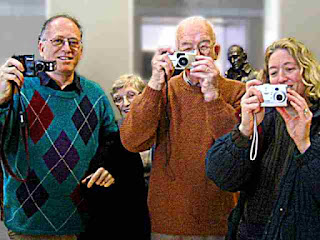Randy Nordschow wrote an article entitled http://www.newmusicbox.org/chatter/chatter.nmbx?id=5192 on the website New Music Box. Yes, it is a completely self-referent title - the title is its own web address. Douglas Hofstadter would understand. Randy's article is not long. Go read it. Here are some quotes:
Yet I get the feeling that composers tend to employ these sorts of tendonitis-inducing strategies—i.e. creating work that only references itself—rather regularly. String Quartet No. 5, Symphony No. 1, Sonata No. 92. Yes, these pieces often also refer to the canonical tradition of western classical music, but what about the real world? ...
As polystylistic endeavors continue to gain momentum and younger composers begin to navigate more effortlessly between genre distinctions, maybe a fresh perspective will eventually emerge. Especially if we continue to stray even further from the path we so often look back to for inspiration and guidance. Yes, tradition is important, but not nearly as important as change.
I intended to write a short comment on New Music Box about "Sonata Heaven" and, as is my wont, I got carried away. I do go on and on about it sometimes, don't I? (Yep.)
Anyway, here's the verbiage:

Years ago, as part of the ICA composers group, I overheard a conversation between two composers one of whom had just written a piece called "Sonata". The second said "That's not a good title. It will just go to
Sonata Heaven."
I believe the first composer took the advice and retitled her piece - and it went to "heaven" (the fictional final resting place for pieces no one ever hears again) anyway. The "Sonata Heaven" concept stuck with me and I expanded it. Every music genre has a heaven: "Symphony Heaven", "Pierrot Ensemble Heaven", "Improvisational Study Heaven", even "Pop Song Heaven."
"Music Heaven" is a big place with a lot of divisions. A final resting place for all the new music which is created beyond the little bit our culture actually wants. The rest are thrown away. The culture is obsessed with finding one more timeless masterpiece or one more next big hit.
Those few chosen pieces are the relevant ones, relevance being bestowed by the context in which the music is heard - not that in which it is created.

But every piece, no matter how forgettable or irrelevant, is essentially a collection of abstract references (as long as you ignore any lyrics). Whether a tone row or a boogie woogie bass line or a Tristan chord - they're all complete abstractions that have been used in the past in ways which now give them meaning.
Some pieces point back to things in that piece itself, like Randy's title, but mostly they point to other similar, previous pieces.
Hardly anyone can relate to a new piece music these days without knowing something about the prior history of its tradition.These modern days are filled with the constant din, a Babel of many musics and sounds. It comes out of our radios, our computers, our iPods, blaring at us from behind television commercials, espresso machines or through our earbuds (possibly all at the same time.) It's intended to calm us down, pep us up, to serve the visual image we're being fed at the same moment, to tease us into downloading the album, or, most likely, to sell us product we don't yet know we want. Music is mostly something which tries to trick us into parting with our cash - for a concert ticket or an album which makes your baby smarter or a Jerry Garcia tie.
Overlapping with the actual composed music blaring forth at us are all the unintentionally musical sounds produced by the people or nature around us. Traffic noise or ringing cell phones or dogs barking or your neighborhood gangs shooting at one another, whatever. Last week, while walking and listening to the Goldberg Variations, I was startled by an entirely new harmony. Thanks to a low-pitch squeal of defective brakes on a nearby car Bach's music was suddenly given an exciting new twist. That's what is called thinking outside the Bachs.
These days music is not something which can easily be created out of silence since real silence is such a rare commodity. You could try moving away from these human sounds - become a hermit - but no matter how far away you get natural sounds will still be there (plus an occasional distant airplane.)

In this context, trying to think outside the box is exceptionally difficult. The cacophonous world - the box - is inescapable and trying to think outside of it will only make you crazy.
This makes creating music kind of like sculpture, something which you carve out of a big block of daily cacophony. The artistry of a composer is more about which elements are left out and how the remaining ones interact to remind us of music and noise we've previously heard.
How about taking everything you hear around you and removing all the things which "don't sound like an symphony" (or a sonata or pop song). You might actually create a symphony (or sonata or whatever) with a chance of being accepted as relevant. Even though each listener will relate to the self-referent sounds differently - according to their personal experiences - they will still relate. That's what a composer ought to be working towards.
But doing this won't do you any good unless you can get people to pay attention Now that's the hard part. There's just so much other interfering noise (and music) getting in the way. Who has time to listen.
Cacophony Tags: Composing. . . music. . . heaven. . . music heavenP.S. I suppose there must be an imaginary music hell to balance the imaginary music heaven, huh? Someone else will have to write about that.







































